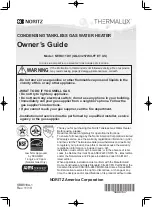
17
R E A D T H I S E N T I R E S E C T I O N B E F O R E
BEGINNING TO TROUBLESHOOT PROBLEMS.
The following troubleshooting guide provides systematic
procedures for isolating equipment problems. This guide is
intended for use by a QUALIFIED GAS HEATER SERVICE
PERSON.
DO NOT ATTEMPT TO SERVICE THESE HEATERS
UNLESS YOU HAVE BEEN PROPERLY TRAINED.
TEST EQUIPMENT REQUIRED
The following pieces of test equipment will be required to
troubleshoot this system with minimal time and effort.
• Digital Multimeter
- for measuring AC and DC voltage and
resistance.
• Thermocouple Diagnostic Kit
- (L. B. White Part No. 550-
08506) When used with a standard digital multimeter,
this kit allows testing of the thermocouple and
electromagnetic power unit strength of the pilot safety gas
control valves.
• Low Pressure Gauge
- for checking inlet and manifold
pressures at the gas control valve against nameplate
rating.
■
Visually inspect equipment for apparent damage.
■
Check all hoses for abrasion and wear. Replace any
that are suspect.
■
Make sure heater is properly installed and meets
minimum clearances to nearest combustible
materials. (Refer to dataplate on heater.)
■
Check all wiring for loose connections and worn
insulation.
To effectively use these flow charts, you must first identify
the problem. The problems are numbered sequentially,
along with a brief explanation of each problem. Start at the
“diamond” closest to the identified problem and proceed
with each step, performing whatever tests are suggested.
After each step or test, the guide will direct the service
person to the next logical step based on the outcome of the
previous check.
Components should be replaced only after each step has
been completed and replacement is suggested in the flow
chart.
The problems are listed below along with the page number
on which you may find the flow chart for the specific
problem.
Problem
Description
Page
1
Pilot will not light . . . . . . . . . . . . . . . . . . . . . . . 19
2
Pilot will not stay lit when pilot control
button is released . . . . . . . . . . . . . . . . . . . . . . 20
3
Motor runs. Burner does not light with
pilot light lit . . . . . . . . . . . . . . . . . . . . . . . . . . . . 21
4
Motor does not run, heater does not light
with pilot light lit . . . . . . . . . . . . . . . . . . . . . . . . 22
5
Main burner cycles on and off repetitively.
Pilot stays lit . . . . . . . . . . . . . . . . . . . . . . . . . . . 23
6
Pilot will not stay lit when main burner and
blower are operating . . . . . . . . . . . . . . . . . . . . 23
7
High limit switch is open . . . . . . . . . . . . . . . . . 24
8
Burner does not shut off . . . . . . . . . . . . . . . . . 25
9
Flame “lifting” off of burner. . . . . . . . . . . . . . . 25
10
Burner flame drops out after 10 - 15
minutes of operation . . . . . . . . . . . . . . . . . . . . 25
11
Gas control valve “chatters” . . . . . . . . . . . . . . 26
12
Motor “hums” . . . . . . . . . . . . . . . . . . . . . . . . . . 26
Troubleshooting Guide
WARNING
Electrical Shock and Burn Hazard
■
Troubleshooting this system may require operating the
unit with line voltage present and gas on. Use extreme
caution when working on the heater.
■
Failure to follow this warning may result in property
damage, personal injury or death.
















































